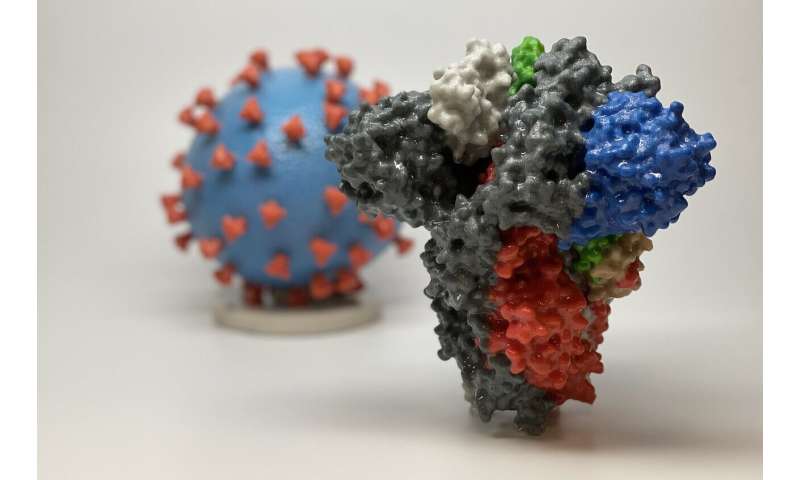Ultraviolet LEDs prove effective in eliminating coronavirus from surfaces and, potentially air and water


As COVID-19 continues to ravage global populations, the world is singularly focused on finding ways to battle the novel coronavirus. That includes the UC Santa Barbara’s Solid State Lighting & Energy Electronics Center (SSLEEC) and member companies. Researchers there are developing ultraviolet LEDs that have the ability to decontaminate surfaces—and potentially air and water—that have come in contact with the SARS-CoV-2 virus.
“One major application is in medical situations—the disinfection of personal protective equipment, surfaces, floors, within the HVAC systems, et cetera,” said materials doctoral researcher Christian Zollner, whose work centers on advancing deep ultraviolet light LED technology for sanitation and purification purposes. He added that a small market already exists for UV-C disinfection products in medical contexts.
Indeed, much attention of late has turned to the power of ultraviolet light to inactivate the novel coronavirus. As a technology, ultraviolet light disinfection has been around for a while. And while practical, large-scale efficacy against the spread of SARS-CoV-2 has yet to be shown. UV light shows a lot of promise: SSLEEC member company Seoul Semiconductor in early April reported a “99.9% sterilization of coronav … ID-19) in 30 seconds” with their UV LED products. Their technology currently is being adopted for automotive use, in UV LED lamps that sterilize the interior of unoccupied vehicles.
It’s worth noting that not all UV wavelengths are alike. UV-A and UV-B—the types we get a lot of here on Earth courtesy of the Sun—have important uses, but the rare UV-C is the ultraviolet light of choice for purifying air and water and for inactivating microbes. These can be generated only via man-made processes.
“UV-C light in the 260—285 nm range most relevant for current disinfection technologies is also harmful to human skin, so for now it is mostly used in applications where no one is present at the time of disinfection,” Zollner said. In fact, the World Health Organization warns against using ultraviolet disinfection lamps to sanitize hands or other areas of the skin—even brief exposure to UV-C light can cause burns and eye damage.
Before the COVID-19 pandemic gained global momentum, materials scientists at SSLEEC were already at work advancing UV-C LED technology. This area of the electromagnetic spectrum is a relatively new frontier for solid-state lighting; UV-C light is more commonly generated via mercury vapor lamps and, according to Zollner, “many technological advances are needed for the UV LED to reach its potential in terms of efficiency, cost, reliability and lifetime.”
In a letter published in the journal ACS Photonics, the researchers reported a more elegant method for fabricating high-quality deep-ultraviolet (UV-C) LEDs that involves depositing a film of the semiconductor alloy aluminum gallium nitride (AlGaN) on a substrate of silicon carbide (SiC)—a departure from the more widely used sapphire substrate.
According to Zollner, using silicon carbide as a substrate allows for more efficient and cost-effective growth of high-quality UV-C semiconductor material than using sapphire. This, he explained, is due to how closely the materials’ atomic structures match up.
“As a general rule of thumb, the more structurally similar (in terms of atomic crystal structure) the substrate and the film are to each other, the easier it is to achieve high material quality,” he said. The better the quality, the better the LED’s efficiency and performance. Sapphire is dissimilar structurally, and producing material without flaws and misalignments often requires complicated additional steps. Silicon carbide is not a perfect match, Zollner said, but it enables a high quality without the need for costly, additional methods.
In addition, silicon carbide is far less expensive than the “ideal” aluminum nitride substrate, making it more mass production-friendly, according to Zollner.
Portable, fast-acting water disinfection was among the primary applications the researchers had in mind as they were developing their UV-C LED technology; the diodes’ durability, reliability and small form factor would be a game changer in less developed areas of the world where clean water is not available.
The emergence of the COVID-19 pandemic has added another dimension. As the world races to find vaccines, therapies and cures for the disease, disinfection, decontamination and isolation are the few weapons we have to defend ourselves, and the solutions will need to be deployed worldwide. In addition to UV-C for water sanitation purposes, UV-C light could be integrated into systems that turn on when no one is present, Zollner said.
“This would provide a low-cost, chemical-free and convenient way to sanitize public, retail, personal and medical spaces,” he said.
For the moment, however, it’s a game of patience, as Zollner and colleagues wait out the pandemic. Research at UC Santa Barbara has slowed to a trickle to minimize person-to-person contact.
Source: Read Full Article